A journey through Egypt’s past and present
Two UCSC professors took a group of history students to Egypt on a first-of-its-kind trip in December, making classroom lessons come alive in a life-changing experience.
Two UCSC professors took 12 history students to Egypt on a first-of-its-kind trip in December, visiting ancient sites and exploring modern cities.
During the 11-day journey, the students got to experience and participate in both life lessons and academic endeavors—haggling for horse-drawn carriage rides to a meeting spot, encountering the ruins of ancient Thebes, and getting to know the world capital that is Cairo.
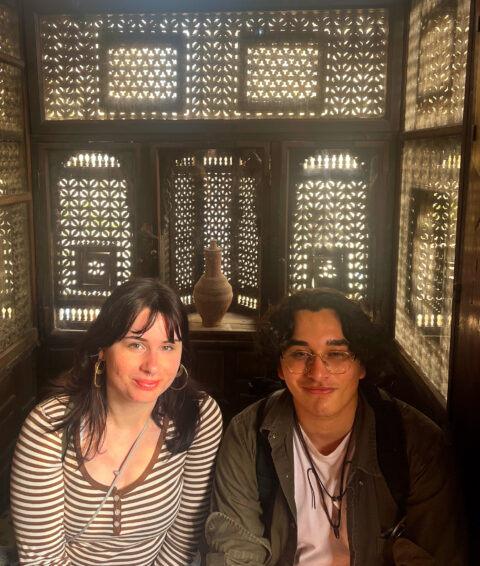
These explorations were part of an immersive tour of Egypt’s past and present. Egyptologist Elaine Sullivan, an associate professor of history, guided their visits to the monuments of the ancient city of Thebes. Founding Director of the Center for the Middle East and North Africa Jennifer Derr, also an associate professor of history, led students through Cairo’s history and daily life in the city.
This was the first time Sullivan and Derr have traveled to Egypt together, though they have traveled there extensively on previous trips.
This was also the first time either professor has traveled to Egypt with UCSC students. They hope that this will not be their last trip with students and that future generations of UCSC students who are passionate about history will have similar opportunities.
The result of this inaugural trip was a perspective on history and its continuing reverberations that couldn’t be gained through books, videos, and other classroom tools.
“On this trip, we were able to expose students to the sites that have defined Egypt’s history while also considering how the significance of these places lives on,” said Derr, who is fluent in Arabic, which is essential for her research. “We explored themes that shape contemporary politics and inform the narratives that give lives meaning.”
Historians’ perspective
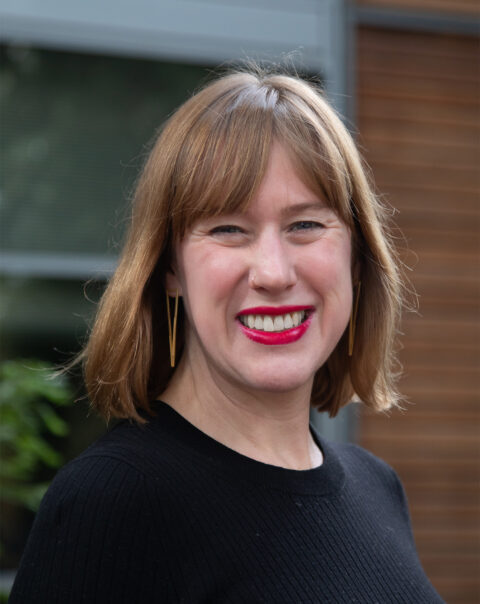
Derr is a historian of the modern Middle East, Egypt in particular, whose research focuses on the histories of science, medicine, the environment, and political economy.
Her coursework includes classes on the social, political, and economic history of the modern Middle East and North Africa. She also teaches courses on the histories of science and medicine.
Sullivan, an archaeologist, specializes in the built environment and religious history of the Pharaonic (2950–332 B.C.E.) and Greco-Roman periods (332 B.C.E.–395 C.E.) of the ancient state.
Eleven undergraduates accompanied the professors. Ingy Higazy (M.A. ’20, politics), a Ph.D. candidate in politics, helped to guide the trip. Higazy is from Cairo and is completing a Ph.D. focused on infrastructure and mobility in the city.
The Humanities Institute at UCSC and the Office of Humanities Dean Jasmine Alinder provided the funding for the trip in order to make this opportunity available to a wide range of students, regardless of their financial resources.
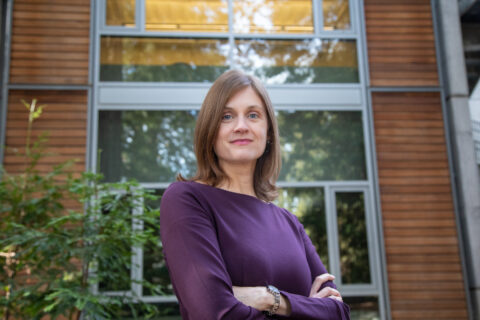
Sullivan and Derr approached the Dean and the Directors at The Humanities Institute at the very beginning of their project.“We wanted to have this trip paid for so that it wasn’t about money—it was about their interest and curiosity,” Sullivan said.
Irena Polić, Managing Director of THI, added “We were lucky that we were able to cover all of the students’ travel costs, thanks to a generous gift from the Helen and Will Webster Foundation. It was important to all of us that this experience was open to all students, and that none of them were going to be left behind because of the lack of resources.”
Alinder said the guided trip exemplified experiential learning in the Humanities at UCSC. “There is really no substitute for the real-world experience,” she said. “The students who went on this trip are studying history, politics, as well as art and visual culture. They brought such a rich set of backgrounds and skill sets to the trip thanks to the courses they took with Professors Derr and Sullivan in the fall quarter. This is exactly the kind of experiential learning opportunity that we would like to make available to all of our students in the humanities.”
She also noted that for some students, this was their first-ever travel experience outside the United States.
A deep immersion
In preparation, the undergraduates took Sullivan’s class, Temple and City: The Egyptian New Kingdom and the City of Thebes, and Derr’s class, Living Egyptian History in the City of Cairo. Both are upper-division history courses.
Those courses gave students a lens for appreciation and interpretation.
“Prior to the trip, I wrote an in-depth essay about the religious reformation led by Pharaoh Akhenaten,” said Isabel de Blois (Kresge ’24, history), referring to a monarch who ruled Egypt for roughly 15 years starting in the early 1350s B.C.E.
Throughout the trip, de Blois could chat as much as she liked with other students on detailed historical topics without wearing out their patience.
“I felt like I could freely talk about what I loved to study without boring others,” she said.
Thousands of years of history in 11 days
The trip kicked off in Cairo, where students toured the city’s old section, dating to the seventh century, and the historic downtown, built in the 19th century.
In that busy city of approximately 20 million people, most of whom are Sunni Muslims, Ivan Hueramo-Abrego (Merrill ’23, history) could see the profound effect that religion has on Egypt’s public life, politics, and culture.
“It was quite a powerful thing to hear the call to prayer ring throughout the city and to watch people take a moment for personal reverence amidst the frenetic chaos of Cairo streets.”
“It was quite a powerful thing to hear the call to prayer ring throughout the city and to watch people take a moment for personal reverence amidst the frenetic chaos of Cairo streets,” Hueramo-Abrego said.
Hueramo-Abrego was surprised by the patterns and norms for public affection on the city streets.
“Men would embrace each other, kiss cheeks, walk arm in arm in the streets, but seeing local Egyptian couples behaving as affectionately was not as common,” he said.
Indescribable experiences
During the trip, Hueramo-Abrego was glad that he had taken UCSC’s introductory Arabic language courses “because I think it’s wonderful to communicate with people in their native language.”
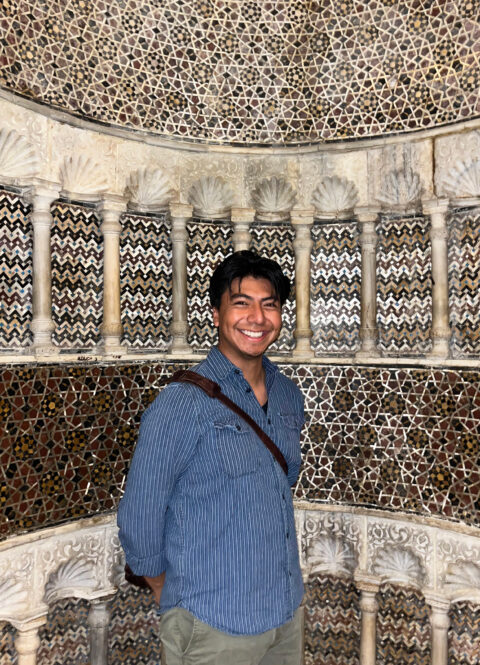
Some of the sensory experiences the group had overseas are difficult to describe in words. While in Cairo, the group explored bazaars and sampled culinary specialties such as flame-roasted camel meat and whole pigeons roasted on a spit.
The first sight of the pyramids at Giza, the peace of sunset as experienced from a sailboat on the Nile, and the vibrant activity with which Cairo throbs at 2 a.m. left a deep impression.
Following a train ride south to Luxor, Sullivan, Derr, Higazy, and the students walked the remains of ancient Thebes (15th–11th centuries B.C.E.), visiting both the east bank of the Nile, with the imposing temples of Karnak and Luxor, and the west bank, the site of the royal and elite necropolises, royal memorial temples, and the village of those who built the Valley of the Kings.
After getting a solid foundation from Derr’s and Sullivan’s courses, these students had a rich context for what they saw, although no amount of lectures, book learning, and database research could prepare them for the emotional impact of monumental sites.
These temples and pyramids of Egypt were not built to human scale. For example, the central monumental stone columns at Karnak Temple’s Great Hypostyle Hall are each 65.5 feet high.
Such massive, attention-grabbing constructions were designed to inspire in people a sense of awe, Sullivan said.
Students told Sullivan and Derr that they could understand why the overwhelming sight of the ancient temples and monuments would make ordinary people living in those times believe that the people who’d built these things were living gods.
Peeks into the past and the future
The students also paid a visit to Deir el-Medina, a village west of Luxor where workmen who constructed tombs of Egyptian kings—including Ramses II—lived with their families.
Excavations in this settlement provide a vivid sense of the occupants’ lives, education, and work, in part because of ostraca—limestone flakes used as primitive notepads—that were recovered from an ancient dumping grounds.
Sullivan said the ostraca provided the touring group with a candid and startling glimpse of the gossip, gripes, and everyday lives of highly educated but non-elite stonecutters, painters, carpenters, and scribes who decorated the tomb of Ramses II, reigning 1279–1213 B.C.E.
“They’re like ancient Post-it notes,” Sullivan said.
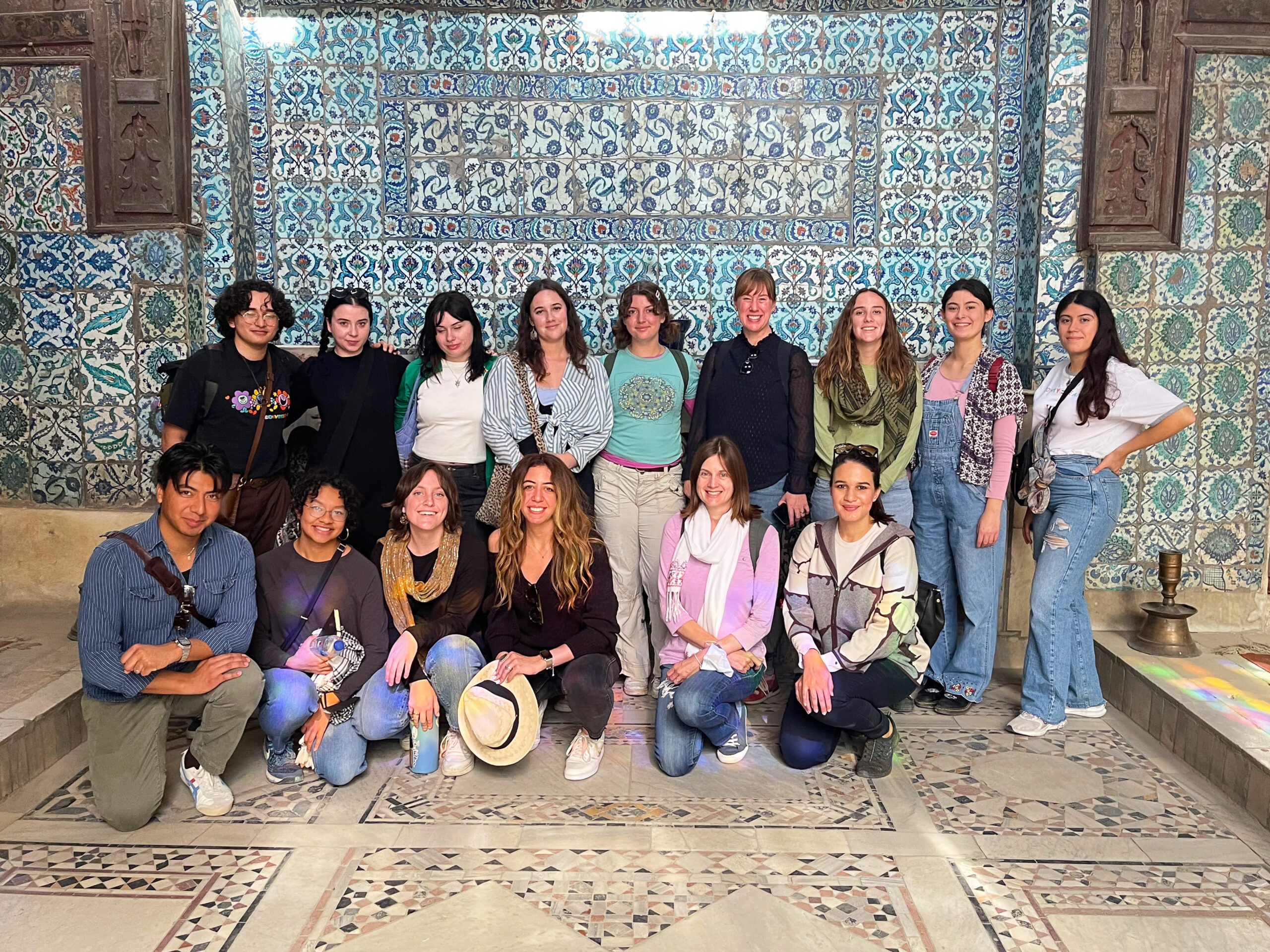
In Cairo, students walked from the old gates of the city, built during the Fatimid period (c. 969–1171 C.E.), down Al-Muizz street, which is lined with important mosques, public water fountains, and schools from the medieval period.
They explored the regions of the city that had been constructed in the 19th century and helped to define the period of British colonialism. Finally, the group cheered for the last matches of the World Cup from packed sidewalk cafés.
This journey that delved deeply into the past and present also gestured toward the future.
The UCSC travelers engaged with 21st-century challenges and considered Egypt’s future, meeting with young Egyptian environmentalists from the local environmental group VeryNile. They discussed wastewater inundation and garbage pollution in the Nile, the waterway that has been a lifeline for the country for thousands of years but is now under threat.
According to recent reports, environmentalists fished more than 37 tons of trash from the waterway in a three-year period.
Transformative tours
Both Sullivan and Derr said they both experienced life-changing trips when they each traveled to Egypt as study-abroad students in college.
They hope the trip will have a similar impact on the students who went with them to Egypt this winter.
“We’re doing this as a collective, right?” Sullivan said. “And that allows the students to learn from each other and learn from the experience.”
“Unlike when you’re traveling by yourself or with one other person, we have an opportunity as a group to step back and say, ‘OK, we all saw this thing that happened on the street today. Why do you think that happened, and how are you interpreting that?’” Derr said. “‘What is the historical or cultural reason behind what you just saw? Let’s talk about those things together based on what we know, and the experiences we’ve had together.”’
A life-changing experience
Before travel, Derr, Higazy, and Sullivan met with students to prepare them for the experiences that they might have and the different cultural and political issues that they needed to consider. The group talked at length so that students would be well prepared when they arrived.
Derr and Sullivan hope the trip has changed the participants’ lives.
Sullivan emphasized the importance of traveling as part of a class.
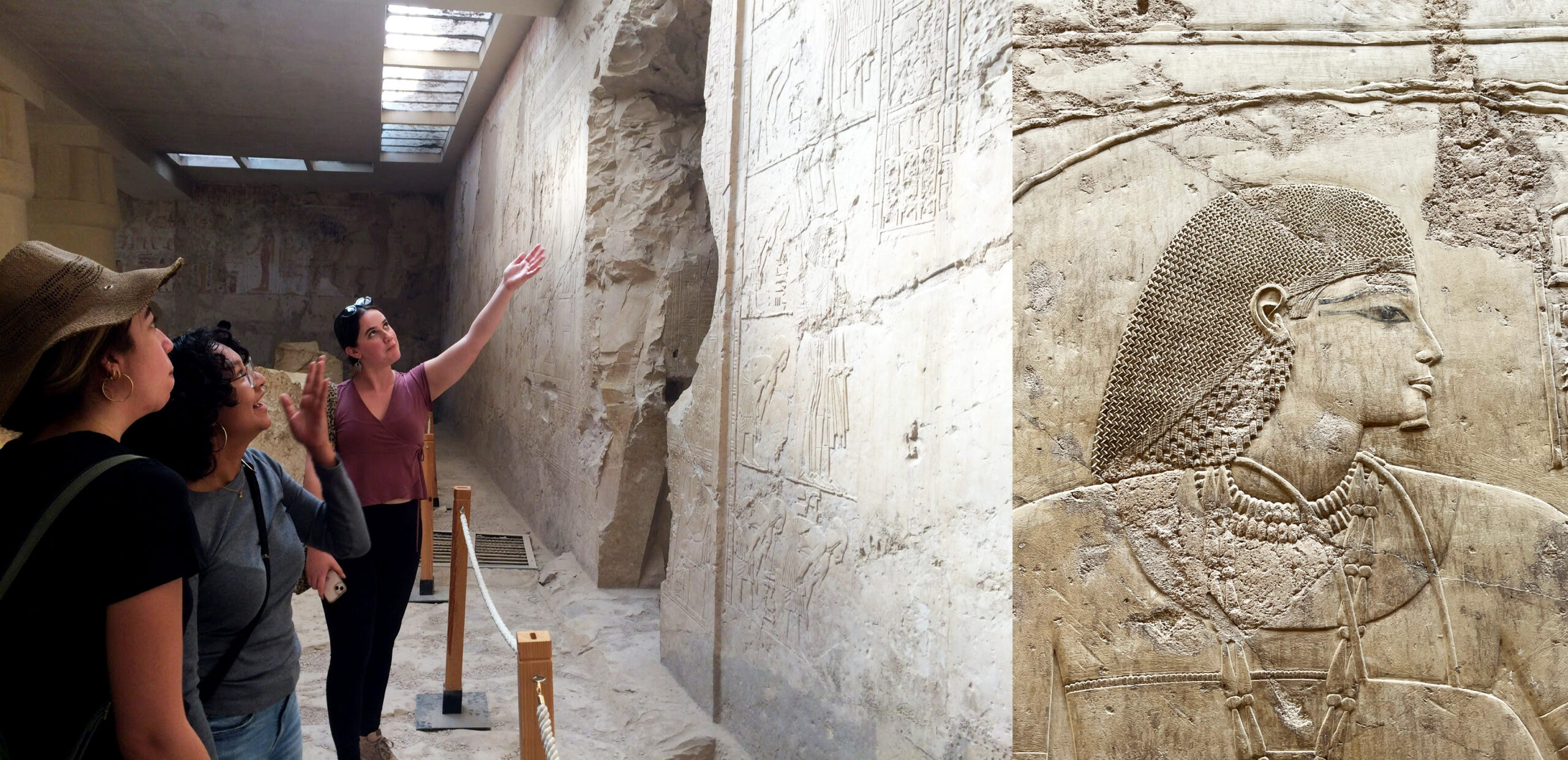
“It’s not that we’re trying to turn them into historians of Egypt or archaeologists,” Sullivan said. “We wanted to show them how important it is to choose a career you are passionate about, and how it’s worth putting that effort in and taking those risks because when it works out, like it has for Jennifer and me, you end up in careers that you really love.”
Indeed, the trip ended up being life-changing for the students who traveled with Derr and Sullivan.
“I learned in this travel experience not to shy away from discomfort, but rather embrace it and take every opportunity to learn about something so unfamiliar to me,” Hueramo-Abrego said.
“For a long time, I was conflicted about where in the Middle East I wanted to focus my studies,” de Blois said. “I was divided between Egypt and Iran. But this trip solidified what I want to do. I want to center Egypt in my studies at UC Santa Cruz, and in my future work.”
Such clarity would have been unimaginable without the tactile experience of exploring the places she had read about, she said.
“When you’re in a classroom it can be difficult to visualize what the professor is teaching, especially when the material is thousands of years old,” said de Blois. “But this trip allowed me to engage with my studies in a way I had never experienced before. I wish I could do it with all of my history classes.”
Original Link: https://magazine.ucsc.edu/2023/03/a-journey-through-egypts-past-and-present/
